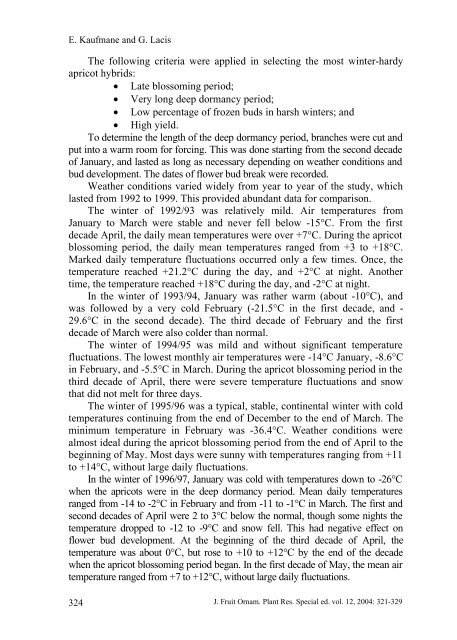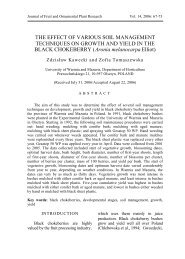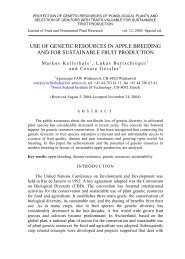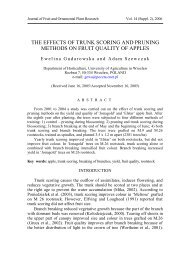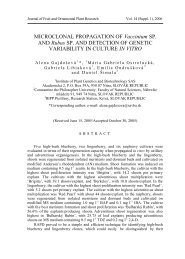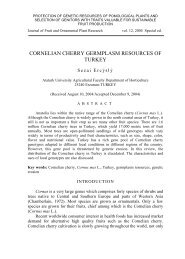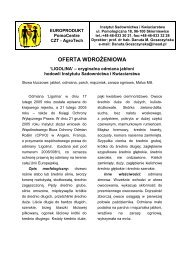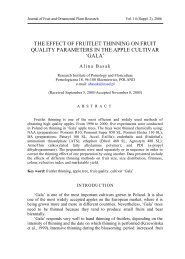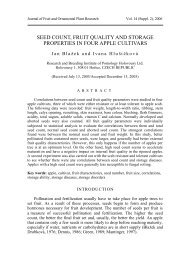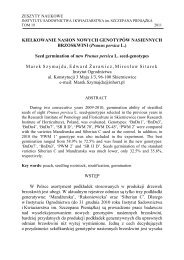Winter-hardy apricots and peaches with good fruit quality in Latvia
Winter-hardy apricots and peaches with good fruit quality in Latvia
Winter-hardy apricots and peaches with good fruit quality in Latvia
You also want an ePaper? Increase the reach of your titles
YUMPU automatically turns print PDFs into web optimized ePapers that Google loves.
E. Kaufmane <strong>and</strong> G. LacisThe follow<strong>in</strong>g criteria were applied <strong>in</strong> select<strong>in</strong>g the most w<strong>in</strong>ter<strong>hardy</strong>apricot hybrids: Late blossom<strong>in</strong>g period; Very long deep dormancy period; Low percentage of frozen buds <strong>in</strong> harsh w<strong>in</strong>ters; <strong>and</strong> High yield.To determ<strong>in</strong>e the length of the deep dormancy period, branches were cut <strong>and</strong>put <strong>in</strong>to a warm room for forc<strong>in</strong>g. This was done start<strong>in</strong>g from the second decadeof January, <strong>and</strong> lasted as long as necessary depend<strong>in</strong>g on weather conditions <strong>and</strong>bud development. The dates of flower bud break were recorded.Weather conditions varied widely from year to year of the study, whichlasted from 1992 to 1999. This provided abundant data for comparison.The w<strong>in</strong>ter of 1992/93 was relatively mild. Air temperatures fromJanuary to March were stable <strong>and</strong> never fell below 15°C. From the firstdecade April, the daily mean temperatures were over +7°C. Dur<strong>in</strong>g the apricotblossom<strong>in</strong>g period, the daily mean temperatures ranged from +3 to +18°C.Marked daily temperature fluctuations occurred only a few times. Once, thetemperature reached +21.2°C dur<strong>in</strong>g the day, <strong>and</strong> +2°C at night. Anothertime, the temperature reached +18°C dur<strong>in</strong>g the day, <strong>and</strong> 2°C at night.In the w<strong>in</strong>ter of 1993/94, January was rather warm (about 10°C), <strong>and</strong>was followed by a very cold February (21.5°C <strong>in</strong> the first decade, <strong>and</strong> 29.6°C <strong>in</strong> the second decade). The third decade of February <strong>and</strong> the firstdecade of March were also colder than normal.The w<strong>in</strong>ter of 1994/95 was mild <strong>and</strong> <strong>with</strong>out significant temperaturefluctuations. The lowest monthly air temperatures were 14°C January, 8.6°C<strong>in</strong> February, <strong>and</strong> 5.5°C <strong>in</strong> March. Dur<strong>in</strong>g the apricot blossom<strong>in</strong>g period <strong>in</strong> thethird decade of April, there were severe temperature fluctuations <strong>and</strong> snowthat did not melt for three days.The w<strong>in</strong>ter of 1995/96 was a typical, stable, cont<strong>in</strong>ental w<strong>in</strong>ter <strong>with</strong> coldtemperatures cont<strong>in</strong>u<strong>in</strong>g from the end of December to the end of March. Them<strong>in</strong>imum temperature <strong>in</strong> February was 36.4°C. Weather conditions werealmost ideal dur<strong>in</strong>g the apricot blossom<strong>in</strong>g period from the end of April to thebeg<strong>in</strong>n<strong>in</strong>g of May. Most days were sunny <strong>with</strong> temperatures rang<strong>in</strong>g from +11to +14°C, <strong>with</strong>out large daily fluctuations.In the w<strong>in</strong>ter of 1996/97, January was cold <strong>with</strong> temperatures down to 26°Cwhen the <strong>apricots</strong> were <strong>in</strong> the deep dormancy period. Mean daily temperaturesranged from 14 to 2°C <strong>in</strong> February <strong>and</strong> from 11 to 1°C <strong>in</strong> March. The first <strong>and</strong>second decades of April were 2 to 3°C below the normal, though some nights thetemperature dropped to 12 to 9°C <strong>and</strong> snow fell. This had negative effect onflower bud development. At the beg<strong>in</strong>n<strong>in</strong>g of the third decade of April, thetemperature was about 0°C, but rose to +10 to +12°C by the end of the decadewhen the apricot blossom<strong>in</strong>g period began. In the first decade of May, the mean airtemperature ranged from +7 to +12°C, <strong>with</strong>out large daily fluctuations.324J. Fruit Ornam. Plant Res. Special ed. vol. 12, 2004: 321329


